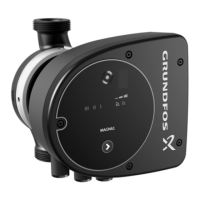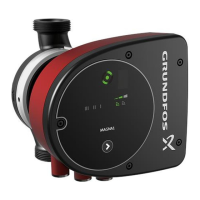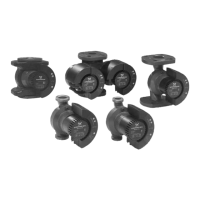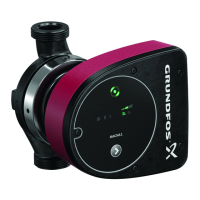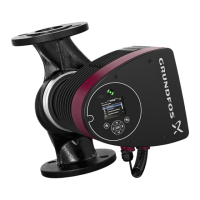Functions
MAGNA3
4
23
Automatic night setback
A night setback system is often integrated into a
building management system (BMS), or as part of an
equivalent electronic control system, which has a
built-in timer.
The feature is not beneficial in rooms with underfloor
heating because of the regulating inertia of the
underfloor heating.
Characteristics and key benefits
• Automatic night setback lowers the room
temperature at night, which reduces heating costs.
• The pump automatically changes between normal
duty and night setback (duty at low demand),
depending on the flow pipe temperature.
• Once activated, the pump runs on the minimum
curve.
Technical specifications
The pump automatically changes to night setback
when the built-in sensor registers a flow-pipe
temperature drop of more than 18 to 27 °F (10 to 15
°C) within approximately two hours. The temperature
drop must be at least 0.18 °F/min (0.1 °C/min).
Changeover to normal duty takes place without time
lag when the temperature has increased by
approximately 18 °F (10 °C).
Note: You cannot enable automatic night setback
when the pump is in constant-curve mode.
Multipump modes
Multipump function
The multipump function enables control of single-head
pumps connected in parallel and twin-head pumps
without the use of external controllers. The pumps in a
multipump system communicate with each other via
the wireless GENIair connection.
Pump system:
• Twin-head pump.
• Two single-head pumps connected in parallel. The
pumps must be of equal size and type. Each pump
requires a non-return valve in series with the pump.
A multipump system is set via a selected pump, i.e. the
master pump (first selected pump). The multipump
functions are described in the following sections.
Alternating operation
Only one pump is operating at a time. The change from
one pump to the other depends on time or energy. If a
pump fails, the other pump will take over automatically.
Backup operation
One pump is operating continuously. The backup
pump is operated at intervals to prevent seizing up. If
the duty pump stops due to a fault, the backup pump
will start automatically.
Cascade operation
Cascade operation ensures that the pump
performance is automatically adapted to the
consumption by switching pumps on or off. The system
thus runs as energy-efficiently as possible with a
constant pressure and a limited number of pumps.
The slave pump will start when the master pump is
running at maximum or has a fault, and it will stop
again when the master pump is running below 50 %.
Cascade operation is available in constant speed and
constant pressure. You can with advantage choose a
twin-head pump as the backup pump will start for a
short period in peak-load situations.
All pumps in operation will run at equal speed. Pump
changeover is automatic and depends on speed,
operating hours and faults.

